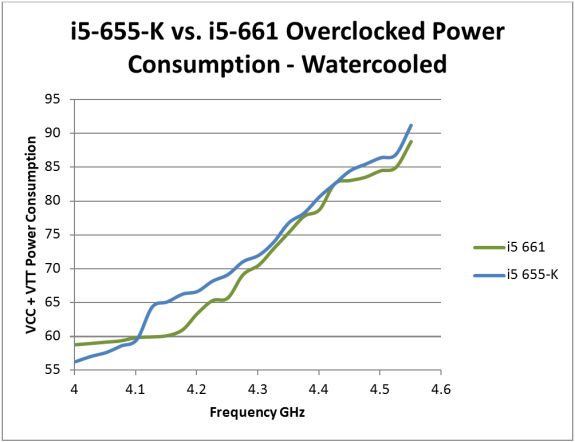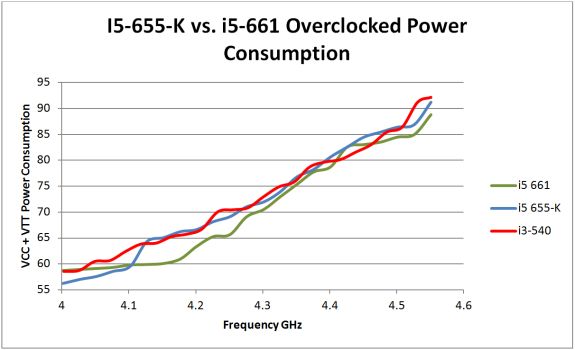i3-540 vs. i5-655K vs. i5-661
Next up, let’s take a look at the power scaling of the i5-665K against the more expensive albeit locked multiplier variant, the i5-661:

We’ve started the scale at 4GHz here, because any variance below this freqeuncy using water-cooling is negligible (around 2W in favour of the i5-655-K due to a lower VTT). The biggest gap we could find over 4GHz is 7 Watts which shows up between 4.1GHz and 4.2GHz where our i5-655K sample needs a rapid hike of VTT to scale. After that, there’s a 2~4W variance at equivalent frequencies favouring the i5-661 - not huge by any means over the frequency band of interest for overclockers using air or water cooling.
At this point, we’ll overlay the i3-540 power consumption figures using the same water-loop for cooling:
With good cooling, the i3-540 is plenty overclockable.
The i3-540 is at an “advantage” in this graph, as we’ve got no choice but to lower the memory multiplier ratio to 2:8 (giving a speed of DDR-3 1584 MHz at 4.554GHz). The i3-540 has a maximum core multiplier of 23x, and given the base clock needed to attain 4.55GHz, we’d be close to DDR3-2000 speeds which is a tall order for this particular CPU. Both the i5-661 and i5-655K are running the 2:10 memory multiplier ratio using a 25x CPU core mutliplier, giving a memory speed of DDR3-1820.
Before we have a quick look at the Lynnfield i7-875-K, one last thing we’d like to compare is how well the i5-655K handles sub-zero temperatures in comparison to the i5-661.
The capabilities of the i5-661 are well known to us, and we’ve already got a number of overclocking results on record to compare against. Given the i5-661 exhibits better frequency scaling relative to applied voltage, it’ll be interesting to see how the i5-655K fares…












51 Comments
View All Comments
Rajinder Gill - Tuesday, June 1, 2010 - link
As the graphs state - this is VCC/VTT power only, the two major power rails of this architecture. The 12V ATX fan headers and PCIe 12V only on the E659 motherboard. Power to DDR3 is not something I focused on but may do in a future piece (there will be a frequency proportional rise in power provided timings are not changed). A very crude guess - I'd expect the rise over stock to be around 5 watts on the DRAM side in this frequency band (and total draw to be no more than 10~15w). Although figures would differ according to the scaling capabilities of various modules.Other than that, there's not much else aside from CPU PLL which is specified at around 1.1 amps at 1.8V (around 2-3 watts tops).
Rajinder Gill - Tuesday, June 1, 2010 - link
EDIT: The 12V ATX fan headers and PCIe 12V only on the E659 motherboard.That should read the 12V ATX line supplies fan headers and PCIe 12V power only. The 3.3v and 5V rails supply DDR, CPU PLL, IOH (and all derivatives such as IOH PLL, SB~IOH termination voltage etc).
Later
Raja
DanNeely - Tuesday, June 1, 2010 - link
Time permitting I'd be interested in seeing those numbers as well. I understand your desire to measure power consumption closer to the source. My concern is that increased power consumption from the secondary items you're not measuring is a black box; while the AC-DC conversion loss in the PSU from measuring power at the wall can be mostly corrected away by looking at what the efficiency rating of the PSU used in the test setup is.DanNeely - Tuesday, June 1, 2010 - link
Time permitting I'd be interested in seeing those numbers as well. I understand your desire to measure power consumption closer to the source. My concern is that increased power consumption from the secondary items you're not measuring is a black box; while the AC-DC conversion loss in the PSU from measuring power at the wall can be mostly corrected away by looking at what the efficiency rating of the PSU used in the test setup is.Rajinder Gill - Tuesday, June 1, 2010 - link
I prefer to keep things at the DC level. There are plenty of articles covering wall level consumption with your standard kill-a-watt type unit (and they also state the PSU used so users can factor out the losses if they know the effective efficiency curve). I think you are worrying too much about the lesser rails. Sure they will make interesting reading at some point - but there is nothing that pulls more than a couple of amps so the effects on power consumption will not be huge.Regards
Raja
Rajinder Gill - Tuesday, June 1, 2010 - link
Ok "DanNeely", this is for you,I just ran tests on the 3.3V and 5V rails. At stock the combined power consumption of these two rails on the E659. Bear in mind this is an enthusiast level board (higher switching losses due to higher switching speeds on VDIMM, plus using an NF200 for PEG multiplexing):
Running DDR3-1333 CAS 8-8-8-24 with 4GB of memory. (3.3v + 5V rails combined).
20.2 watts idle
Linpack load = 26.36 Watts.
That's a change of 6 Watts between idle and load.
At 4.551GHz, now running DDR3-1820 (1.60 VDIMM):
Idle = 22.86 Watts (2 Watt idle increase)
Load = 27.86 Watts.
That's a 1 Watt increase over stock speeds under load with an overclock of 1GHz on the CPU (running QPI over 4GHz). Hardly worth writing about. Do note - the effective change will vary from board to board according to VRM switching efficiency (which is coming into play if you look at the deltas between idle and load). Of course, I am not including things like HDD's etc although, some of the static 3.3V and 5V rail consumption is due to the GPU (GTX 275) which also draws a little power from that rail.
Hope that answers your questions.
Regards
Raja
DanNeely - Tuesday, June 1, 2010 - link
yes it did. thank you.tno - Friday, May 28, 2010 - link
Setting aside typos, I know wall of text is to be avoided but this felt almost like the opposite problem. Additional clicks for additional adviews. Clearly you didn't like what you saw out of the chips despite the voltage improvements evident in the more modest chip. Yet in the end despite devoting 1/9th of the coverage to it, you reward your recommendation to the pricier chip just one page after showing it severely underperforming its non-K analogue in both overclocking and voltage.I have said it before and I think its worth mentioning again, clearly there is a lo of passion for tech in the growing AnandTech team, but maybe adding a team member whose passion is writing and across whose hands every article will pass would give the site that extra polish that elevates it from other tech sites.
Jason
7Enigma - Friday, May 28, 2010 - link
At first I thought the same thing (saying nothing at all in the final page about the 655K does leave me puzzled as it is good), but Rijinder did clarify his recommendation for the 875K by saying PRICE. He is saying for the price of these chips and where they fall in line with the rest of the offerings from AMD and INTEL, the 875K is in a sweet spot. Remember the 655K is a dual-core,4 thread chip for $215 (lots of competition from both camps), while the 875K is a quad-core, 8 thread chip for under $350.In the end (and after re-reading the conclusion and article) I think the last page needs to have a bit more meat behind it. The data in the article itself is very detailed, but the final wrap-up needs some work. But honestly, since it's a free site, I'll take the good data and sketchy conclusions (I tend to make my own).
Thanks for the article!
troun - Friday, May 28, 2010 - link
"Past 3.9GHz, we’re already looking at a 10W increase in power consumption for every 20 MHz rise in CPU frequency"
But I read 20W for 100Mhz (or 10W for 50Mhz), with ~160W @ 3.9Ghz and ~180W @ 4Ghz...
However very interesting article, a similar curve (W/Mhz) would be also appreciate for an i7 9x0 comparison, 32nm Vs 45nm (980 Vs 930?).